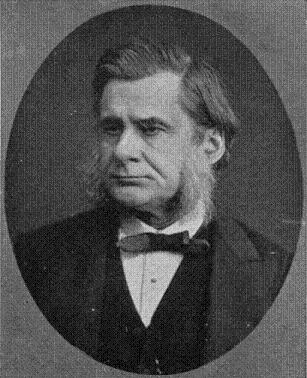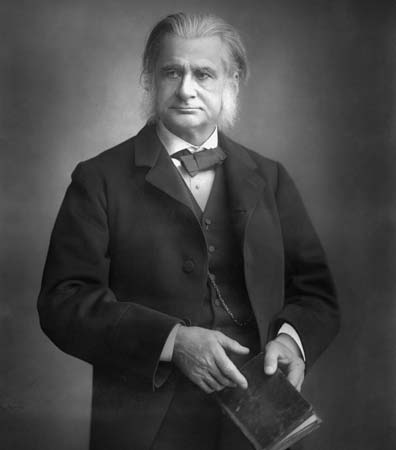|
|
 Thomas Henry Huxley was born May 4, 1825 in Ealing near London. His family circumstances were said to be “straitened”[1] (difficult due to falling on hard times). At that time, he left school at the age of 10 after only two years of formal schooling. He was a self-taught intellect who gained knowledge by reading scientific, history and philosophy works, studying nature, and performing experiments on his own. He also taught himself several different languages; German, Latin and Greek. Thomas Henry Huxley was born May 4, 1825 in Ealing near London. His family circumstances were said to be “straitened”[1] (difficult due to falling on hard times). At that time, he left school at the age of 10 after only two years of formal schooling. He was a self-taught intellect who gained knowledge by reading scientific, history and philosophy works, studying nature, and performing experiments on his own. He also taught himself several different languages; German, Latin and Greek.
From age 13 to 16, Huxley was an apprentice with several medical practitioners before receiving some formal medical training at Sydenham College, which was not a highly respected college. All this time, Huxley continued a program of reading which proved to make up for his lack of formal education. His efforts in educating himself paid off in excellent exam scores and prizes which led to a scholarship at London’s Charing Cross Hospital and receiving his medical degree from the University of London in 1845 and was admitted to the Royal College of Surgeons.
A year later Huxley joined the Royal Navy was eventually assigned to the HMS Rattlesnake as assistant surgeon. The HMS Rattlesnake was a frigate converted to a survey ship designed and equipped to carry out research at sea. The Rattlesnake was used in the research of Australian waters by Surgeon John Thomson, Assistant Surgeon Huxley and botanist John MacGillivray. Huxley’s tour of duty in the Australian waters ended in 1850. Although it was not Huxley’s job, he spent his time studying the zoology of the ocean resulting in the zoological class Hydrozoa (sea anemones, corals, and jellyfish). He returned to London in 1850, but was retained by the Royal Navy as an assistant surgeon until 1853.
Upon his return to London in 1850, Huxley spent his time writing popular science articles which won him recognition among scientists like botanist Joseph Hooker, geologist Charles Lyell, philosopher Herbert Spencer and naturalist Charles Darwin, thus entering the British scientific world. His efforts and the influence from other scientists resulted in his election to the esteemed Royal Society followed by being appointed professor of natural history at the School of Mines. This began Huxley’s study of Paleontology and geology. He chaired this position for thirty-one years retiring after a bout with depressive illness. He also established the X Club for himself and his influential scientific friends in an effort to control the politics of the Royal Society Council.
 From 1860 until Huxley’s death, he continued to educate others by lecturing on science for the general public and talking on biology and other aspects of science to enthusiastic crowds. His lecturing led to several scientific feuds (debates) during his career. One with Richard Owen, the head of the British Natural Science community, over whether dinosaurs were related to mammals (Owen’s view) or to reptiles (Huxley’s view and turned out to be correct). The two, Huxley and Owen, also argued over the relationship between humans and apes. Owen thought the relationship was superficial, while Huxley thought the relationship was due to evolution. Probably the best known debate over evolution came in 1860 when
Huxley defended evolution against Oxford bishop Samuel Wilberforce. From 1860 until Huxley’s death, he continued to educate others by lecturing on science for the general public and talking on biology and other aspects of science to enthusiastic crowds. His lecturing led to several scientific feuds (debates) during his career. One with Richard Owen, the head of the British Natural Science community, over whether dinosaurs were related to mammals (Owen’s view) or to reptiles (Huxley’s view and turned out to be correct). The two, Huxley and Owen, also argued over the relationship between humans and apes. Owen thought the relationship was superficial, while Huxley thought the relationship was due to evolution. Probably the best known debate over evolution came in 1860 when
Huxley defended evolution against Oxford bishop Samuel Wilberforce.
Huxley was an active advocate of Charles Darwin and his evolution theory. Huxley’s lectures on the subject were instrumental in the acceptance of Darwin’s theory of evolution by other scientists and the public. Huxley defended Darwin and his theory with such passion that he earned the name “Darwin’s Bulldog.”
Katheryn M. Auton
Joshua Withers
|


 Thomas Henry Huxley was born May 4, 1825 in Ealing near London. His family circumstances were said to be “straitened”[1] (difficult due to falling on hard times). At that time, he left school at the age of 10 after only two years of formal schooling. He was a self-taught intellect who gained knowledge by reading scientific, history and philosophy works, studying nature, and performing experiments on his own. He also taught himself several different languages; German, Latin and Greek.
Thomas Henry Huxley was born May 4, 1825 in Ealing near London. His family circumstances were said to be “straitened”[1] (difficult due to falling on hard times). At that time, he left school at the age of 10 after only two years of formal schooling. He was a self-taught intellect who gained knowledge by reading scientific, history and philosophy works, studying nature, and performing experiments on his own. He also taught himself several different languages; German, Latin and Greek.
 From 1860 until Huxley’s death, he continued to educate others by lecturing on science for the general public and talking on biology and other aspects of science to enthusiastic crowds. His lecturing led to several scientific feuds (debates) during his career. One with Richard Owen, the head of the British Natural Science community, over whether dinosaurs were related to mammals (Owen’s view) or to reptiles (Huxley’s view and turned out to be correct). The two, Huxley and Owen, also argued over the relationship between humans and apes. Owen thought the relationship was superficial, while Huxley thought the relationship was due to evolution. Probably the best known debate over evolution came in 1860 when
Huxley defended evolution against Oxford bishop Samuel Wilberforce.
From 1860 until Huxley’s death, he continued to educate others by lecturing on science for the general public and talking on biology and other aspects of science to enthusiastic crowds. His lecturing led to several scientific feuds (debates) during his career. One with Richard Owen, the head of the British Natural Science community, over whether dinosaurs were related to mammals (Owen’s view) or to reptiles (Huxley’s view and turned out to be correct). The two, Huxley and Owen, also argued over the relationship between humans and apes. Owen thought the relationship was superficial, while Huxley thought the relationship was due to evolution. Probably the best known debate over evolution came in 1860 when
Huxley defended evolution against Oxford bishop Samuel Wilberforce.